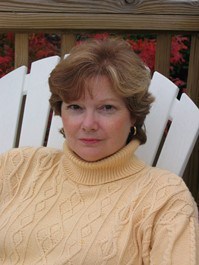Edith Maxwell's Blog, page 282
July 3, 2014
Maple Mayhem Week: Your Favorite Maple Recipes
 As we all know, Maple Mayhem is released this week. We love the maple recipes Jessie includes in her books, and being New Englanders, we have a few of our own to share:
As we all know, Maple Mayhem is released this week. We love the maple recipes Jessie includes in her books, and being New Englanders, we have a few of our own to share:
Julie: Brussel Sprouts, Bacon, and Maple Syrup. I’ll just let that sit for a bit. I first saw this recipe on Boston.com, and have tweaked it a bit over the years.
2 pounds Brussels sprouts, trimmed and halved
2 tablespoons olive oil
3 tablespoons maple syrup
5 slices of bacon, cut into 1/2-inch pieces
Salt and pepper, to taste
1. Set oven at 400 degrees. Have on hand a large rimmed baking sheet.
2. In a bowl, toss the Brussels sprouts with olive oil, maple syrup, bacon, salt, and pepper. Spread the mixture in a single layer on the baking sheet.
3. Roast for 25 to 30 minutes, turning several times, or until the Brussels sprouts are tender and caramelized and the bacon is crisp and golden. This can take up to 40 minutes.
You can also add carrots or parsnips to the mix.
Edith: Geez. I don’t use maple syrup anywhere except on top of pancakes and French toast. So here’s my favorite pancake recipe, that I got from a certain Country Store Mysteries series.
 Whole Wheat Banana Walnut Pancakes
Whole Wheat Banana Walnut Pancakes
Ingredients:
2 c whole wheat flour
1 T baking powder
1 t salt
1 T brown sugar
3 eggs
2 c milk or buttermilk (of any fat content)
¼ c oil
½ c finely chopped walnuts
2 bananas, thinly sliced
Butter for cooking
Greener Pastures maple syrup
Plain or vanilla yogurt, or sour cream.
Directions:
1. Preheat a wide skillet or griddle to medium.
2. Mix the dry ingredients together.
3. Beat the eggs, then add the milk and oil.
4. Stir in the dry ingredients and beat until smooth.
5. Fold in the walnuts and bananas.
6. Melt one T of butter in the pan and spread it evenly.
7. Form pancakes of the size you like and cook until bubbles form and pop.
8. Flip the cakes and cook until done.
9. Serve with warm syrup and top with butter, yogurt, or sour cream.
 Barb: Did you ever have one of those situations where you are asked for something and you’re like–”Oh my gosh, I have exactly the thing right here!” Well that just happened to me. I needed a recipe with maple syrup and there’s one in Musseled Out, the third Maine Clambake Mystery, which I have just turned in to my editor. It’s a fall book, and the recipe is for Grandma Snowden’s Pumpkin Whoopie Pies. Whoopie pies are the State Snack of Maine, where they were invented. (Unless you believe some crazy people from Pennsylvania.) So it’s Sugar Grove meets Busman’s Harbor. I smell cross-over. The recipe is long, so I put it on a separate page, with a link here.
Barb: Did you ever have one of those situations where you are asked for something and you’re like–”Oh my gosh, I have exactly the thing right here!” Well that just happened to me. I needed a recipe with maple syrup and there’s one in Musseled Out, the third Maine Clambake Mystery, which I have just turned in to my editor. It’s a fall book, and the recipe is for Grandma Snowden’s Pumpkin Whoopie Pies. Whoopie pies are the State Snack of Maine, where they were invented. (Unless you believe some crazy people from Pennsylvania.) So it’s Sugar Grove meets Busman’s Harbor. I smell cross-over. The recipe is long, so I put it on a separate page, with a link here.
Jessie: One of my favorite maple recipes is one that is perfect for those last minute calls you get to contribute something to a bake sale. It is quick, easy and gets rave reviews.
Maple Blondies
1 stick or 1/2 cup of butter
¾ cup light brown sugar
¼ cup pure maple syrup
1 large egg
½ teaspoon maple extract
1 cup all purpose flour
¼ teaspoon nutmeg
a pinch of salt
Preheat the oven to 350 F. Spray a 8 x 8 baking dish with non-stick cooking spray.
In a saucepan heat the butter and brown sugar over low heat until the butter is melted and the sugar is dissolved. Remove from heat and stir in the maple syrup, egg, and maple extract. In a separate bowl whisk together the flour, nutmeg and salt. Add the dry ingredients to the contents of the saucepan. Whisk together until smooth. Pour into prepared baking dish and bake for 22-28 minutes.
These are meant to be soft, even a bit undercooked by most baking standards. If this is not to your liking, increase the baking time by three-minute intervals until a desired degree of firmness is achieved.
Sherry: I confess I don’t have a lot of recipes that use maple syrup. I, like Edith, usually use it on pancakes or French toast. However, I did hit on something really simple. Even been trying to eat less carbs and The South Beach Diet has dessert recipes that call for ricotta cheese and things like mini chocolate chips, vanilla or lemon zest. I’m sure you can see where this is going. One night we didn’t have any of those things but we did have maple syrup so we tried a half cup of ricotta with a drizzle of maple syrup. It’s delicious.
Readers: Any favorite maple syrup recipes?
Filed under: Recipes Tagged: Banana-walnut pancakes, Country Store Mysteries, Maine Clambake Mystery, maple blondies, Maple Mayhem, musseled out, pumpkin whoopie pies, Sugar Grove Mysteries

July 2, 2014
You Don’t Need a Sweet Tooth to Love Sugar Grove
On Wicked Wednesdays, we all chime in on a topic. This week, we’re celebrating the release of Jessie Crockett’s second Sugar Grove Mystery, Maple Mayhem. So Wickeds, and readers, what do you love most about this series (besides the maple syrup, maple candy and all the other sweets)?
Liz: I just love Dani’s voice. She’s a fun, fearless heroine who has such an interesting take on her small town and its quirky happenings. The setting is fabulous too – the small town-ness oozes out on every page, just like the yummy maple syrup.
Barb: I love the way, in Drizzled with Death, Jessie told us so much about the Greene family, but kept so much back. Why do three generations live in the same house? Why are they all named after shades of green–and what shade does Dani’s name represent. (Is it incredibly obvious? Am I just being dense about I?)
Sherry: I haven’t figured out her name either, Barb. Dani Greene is short and Jessie turns that lack of height into a very funny part of the book. I always love some romance with my mysteries and Dani’s love life is a mess. I wonder if it will go more smoothly in Maple Mayhem but I’m guessing it won’t.
Julie: There is a lot to love with this series. First of all, as the other Wickeds mentioned, Dani is a wonderful protagonist. Second, there is a real sense of place, and family, that I love. And third? Jessie always surprises me. In Drizzled with Death, I still remember the animals, and laugh. Where did she even come up with that? I can’t wait to see what Maple Mayhem has in store for me.
Edith: Agree with all of the above! It must be said that Dani and Jessie have a lot in common, in their funny fearlessness, energy for life, and devotion to family. I can’t wait to see what trouble Jessie has put her alter ego in this time.
Readers: What’s your favorite part of Sugar Grove and its residents? Got a question for the author?
Filed under: Book Release Tagged: Jessie Crockett, Maple, Maple Mayhem, maple syrup, Sugar Grove Mysteries

July 1, 2014
Happy Wicked Book Birthday Jessie Crockett!
[YESTERDAY'S WINNERS of They Danced by the Light of the Moon: Mark and Reine! Contact Edith to get in touch with Tempa.]
Maple Mayhem – Jessie Crockett’s new mystery- releases today! Happy book birthday,  Jessie!
Jessie!
In Sugar Grove, New Hampshire, people are serious about their maple syrup—especially Dani Greene, whose family owns the Greener Pastures sugarhouse. But when murder disrupts the small-town sweetness, Dani pores over clues to draw out a killer…
Despite being a fourth-generation syrup maker, Dani isn’t stuck in the past. She’s starting a new agricultural cooperative that reduces costs for every syrup producer who joins. Everyone considers it a sweet deal except the die-hard curmudgeon Frank Lemieux—and when a saboteur starts targeting supporters, everyone suspects Frank.
But it turns out they’re barking up the wrong tree when Dani finds Frank murdered in his own sugarhouse. As the sabotage continues, she realizes that Frank was framed. With the help of her family, and a handsome official from the Fish and Game Department, Dani  must catch the killer before another syrup maker kicks the bucket. Recipes included.
must catch the killer before another syrup maker kicks the bucket. Recipes included.
Edith: I wonder if there’s a maple-syrup-and-bubbly recipe in there that we can toast Jessie’s release with? Congratulations!
Barb: I’m so excited about this book! Luckily, I’ll see Jessie at Books in Boothbay on July 12th and be able to score my copy. I don’t know about the rest of you, but after Drizzled with Death, I have lots of questions about Dani and the whole Greene family. Can’t wait!
Liz: Yay, Jessie! I can’t wait to see what Dani and everyone are up to now. Loved Drizzled with Death and very excited for Maple Mayhem! Congratulations!!
Sherry: I am heading to the nearest book store tomorrow to get the second in her series. I can’t wait to read more about Dani and her crazy family! I just realized Barb mentioned the family too — but what can I say — they are one fun group!
Julie: I can’t wait to read this next book in the series! Kindle is all set for downloading, but I am also going to head out to a brick and mortar store. Nothing quite so thrilling as seeing your friends on the shelf!
Filed under: Group posts Tagged: Berkely Prime Crime, Jessie Crockett, Maple Mayhem, Sugar Grove Mystery

June 30, 2014
Tempa Pagel and a Special Librarian
I’m delighted to welcome my longtime writing friend Tempa Pagel to the blog today. Tempa and I met more than twenty years ago in the first fiction writing group I belonged to. She’s written two beautiful and intriguing books set in Newburyport, both with chapters set in present day as well as in the past. You’ll love her new book, They Danced by the Light of the Moon, as well as today’s tale of an amazing librarian.
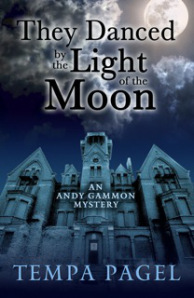 They Danced by the Light of the Moon is another dual mystery, set in two time periods—1901 and the present. Andy and her mother-in-law Mayta are at the reopening gala of a seaside Victorian grand hotel when a fellow diner is murdered during a tour. A suspicious overheard conversation draws Andy into the mystery of why the woman was killed in the same hotel room another woman disappeared from more than a century before. Edith: Versions of the Wentworth-by-the-Sea Hotel in Newcastle, New Hampshire, and the old State Lunatic Hospital at Danvers are almost characters in this book. Fascinating! And she’s giving away two ARCs of the book to two lucky commenters.
They Danced by the Light of the Moon is another dual mystery, set in two time periods—1901 and the present. Andy and her mother-in-law Mayta are at the reopening gala of a seaside Victorian grand hotel when a fellow diner is murdered during a tour. A suspicious overheard conversation draws Andy into the mystery of why the woman was killed in the same hotel room another woman disappeared from more than a century before. Edith: Versions of the Wentworth-by-the-Sea Hotel in Newcastle, New Hampshire, and the old State Lunatic Hospital at Danvers are almost characters in this book. Fascinating! And she’s giving away two ARCs of the book to two lucky commenters.
I’ve Always Admired Librarians
Have you had an experience with a librarian that has caused you to look at the profession in a different way? I’ve always loved libraries and while I appreciate librarians, I’ve never really thought much about them past their roles as keepers of books and purveyors of information. An experience a couple of months ago pointed out to me how important these dedicated and unassuming individuals often are.
Against what was probably my better judgment, I accepted an event in a city two hours away from my Massachusetts home. It was early in the promotion phase of my new book, so, flattered that a librarian wanted me to speak at her library, I leapt at the chance. I looked on a map, saw that it was a pretty large city, and that it was accessible by major highways. So that I could devote the day to the event, I set up a time during my spring vacation week.
On the appointed day, my husband and I drove out together. As we entered the city, we  noticed a number of rundown and vacant buildings. My first thought was that my talk about how two derelict buildings inspired me to write a mystery might be a frivolous topic for this venue. My second thought was that the few people I saw on the streets did not strike me as those who might be willing or able to shell out $25 for a cozy mystery in hardback. Still, the librarian had encouraged me to bring stock to sell, so I remained optimistic.
noticed a number of rundown and vacant buildings. My first thought was that my talk about how two derelict buildings inspired me to write a mystery might be a frivolous topic for this venue. My second thought was that the few people I saw on the streets did not strike me as those who might be willing or able to shell out $25 for a cozy mystery in hardback. Still, the librarian had encouraged me to bring stock to sell, so I remained optimistic.
Since we were early, we did a little exploring. The architecture of the area, although no longer grand, told a story of early wealth, and while there were a few encouraging signs of a comeback—a new or restored building here and there— it was clear that this once thriving industrial city had been in decline for many years.
 Proceeding on to our destination, we came to a neighborhood of abandoned and shabby row houses encircling an expanse of park. Upon a rise, in the middle of this respite of grass and trees, stood the library, a beautiful limestone neoclassical structure with massive columns, that could easily fit in should it be plopped down amidst government buildings in Washington DC. We drove around to the entrance at the back of the hundred-year-old building and found another surprise: a modern multi-story glass addition, which was specially designed to enhance the original architecture. Here, in the heart of a down-on-her-luck city stood a real gem.
Proceeding on to our destination, we came to a neighborhood of abandoned and shabby row houses encircling an expanse of park. Upon a rise, in the middle of this respite of grass and trees, stood the library, a beautiful limestone neoclassical structure with massive columns, that could easily fit in should it be plopped down amidst government buildings in Washington DC. We drove around to the entrance at the back of the hundred-year-old building and found another surprise: a modern multi-story glass addition, which was specially designed to enhance the original architecture. Here, in the heart of a down-on-her-luck city stood a real gem.
Inside, the woman at the desk did not know where the main librarian was, but contacted the children’s librarian, who took us to where I would be speaking and, as the room was not yet ready, helped us set up tables and chairs. He also did not know where the librarian was, but encouraged me to seek him out if I needed anything else. My husband and I sat  down and watched through the floor to ceiling windows for people to come to the entrance. Very few did, and none came into the large room where we waited. Time to begin came and went. Five, ten, fifteen minutes passed. No librarian, no audience. The room hadn’t been set up for me; did I have the wrong day? But no, I’d touched base with the librarian earlier that week and all was well then. We continued to wait.
down and watched through the floor to ceiling windows for people to come to the entrance. Very few did, and none came into the large room where we waited. Time to begin came and went. Five, ten, fifteen minutes passed. No librarian, no audience. The room hadn’t been set up for me; did I have the wrong day? But no, I’d touched base with the librarian earlier that week and all was well then. We continued to wait.
Finally, the librarian came bustling in, apologizing for her tardiness, explaining that she had had important reports to get out. She sat down and was immediately attentive to us. She had advertised my event in all the usual places, she said, and was surprised at the lack of attendees. We decided that maybe school vacation week had taken people away. She promised to buy my book for the library, and then began to talk candidly about the history of the city, its economic decline and the change in demographics, which had resulted in a waning interest in and support of the library.
She was optimistic, however, that things were on an up swing. She talked about important investments that were coming to the city. She was proud that recent fund raising had resulted in the restoration of the library and its new addition. When it was clear that nobody would be attending my talk, she took us on a tour, climbing from floor to floor, moving between eras?daylight streaming through new glass highlighting the gleaming oak woodwork and flooring of the original section—truly a beautiful blending of old and new. We admired the teen room, the computer room, the new shelves awaiting books, the cozy reading areas.
She explained that, although they now had a state-of-the-art library, they lacked funding for sufficient staff to run it. I understood then why a room hadn’t been ready for me, and why the woman at the desk wouldn’t know where the librarian was because she could be in any one of a hundred places doing a hundred essential tasks.
But the librarian didn’t complain about being overburdened, she spoke enthusiastically about events that had taken place and plans for more in the future: storytelling and parties for children held on the park lawn; readings by authors; performances by actors and musicians. It would take time, but the people would come back to the library, and the library would once again become a vibrant center in the city. As she talked, it was easy to visualize the empty space around us buzzing with activity.
In the course of our conversation, I learned that this enthusiastic young Hispanic woman lived within walking distance, somewhere in the sea of run-down housing that surrounded us, within the community she said didn’t read and weren’t comfortable with libraries, the community to which she belonged. I realized that she was more than a librarian; she was an ambassador for her city and a one-woman driving force with a vision to bring books and art and learning to her people. She was also a good salesperson. When she mentioned that she would like to have me come back in the summer to attend one of these events, I had to bite my tongue to stop the yes from rolling off it.
By the end of our hour and half together, I no longer cared that, in my usual estimation, the event would be considered a bust. In fact, to focus on whether or not I sold a few books now seemed trivial, even greedy, compared to the mission this librarian had undertaken and had shared with us. As we drove out of the city, I saw things differently: restored houses I had missed before, their vacant and run-down neighbors taking on new promise. It occurred to me that while it was the city leaders who were working to encourage economic investment, nobody might be more influential in advocating for and in creating support for a renaissance in the city than this woman in her humble position of librarian.
Tempa Pagel was born in Pontiac, Michigan. She is a middle school teacher, currently residing with her husband in the historic city of Newburyport, Massachusetts. She has two grown children, whose early antics have often found their way onto the pages of her books. They Danced by the Light of the Moon is her second Andy Gammon mystery.
Readers: Questions for Tempa? Other librarian stories? Have you read other mysteries that go back and forth between the present and the past?
Filed under: Guest posts Tagged: Five Star Publishing, libraries, Newburyport, tempa pagel, they danced by the light of the moon

June 27, 2014
Ask the Editor — Researching in the Present
By Sherry from Northern Virginia
We are starting an Ask the Editors column where we will be talking to independent edtiors on how to improve your manuscript. I’m first up. Yesterday, Edith talked about researching historical details which leads nicely to my topic of getting it right in the present day. I don’t think writers always research their present day characters as thoroughly as they might a historical character.
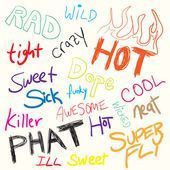 Watch out when using slang. Slang evolves from generation to generation and the word you used to describe something when you were a teen is likely obsolete now. Slang can take me out of a story as fast as the overuse of big words or head hopping. I recently edited a manuscript that had a teenager using the word “phat”. Phat was used in the nineties. There are various stories about its origin from Pretty, Hot and Tempting to a shorten version of party hat. It was usually used as a synonym for “cool”.
Watch out when using slang. Slang evolves from generation to generation and the word you used to describe something when you were a teen is likely obsolete now. Slang can take me out of a story as fast as the overuse of big words or head hopping. I recently edited a manuscript that had a teenager using the word “phat”. Phat was used in the nineties. There are various stories about its origin from Pretty, Hot and Tempting to a shorten version of party hat. It was usually used as a synonym for “cool”.
Interestingly, “cool” has survived in its modern form since the 1950s. But other words like Yolo (you only live once), that came from abbreviations from texts, are short lived and now widely mocked when used by teens and twenty somethings. I found that the Urban Dictionary is a good resource for researching slang terms.
Slang can be used if you want to identify someone who is stuck in the past. An aging hippie who is still walking around saying: groovy, far out, and peace. Or a valley girl who always says like and totally.
 Fashion can be another trap. A manuscript I edited had a teenage girl wearing her Uggs out into a raging blizzard on purpose. Uggs are a fashion statement and, at least with my daughter and her friends, would no more be worn into a snow storm than peep-toed stilettos. On our retreat someone mentioned that the denim industry was hurting because yoga pants are so popular not only with teens but through thirty-somethings. My protagonist is 38 and she is usually wearing jeans but I’ve added some yoga pants into her wardrobe. Yoga pants are probably a phase like flannel pajama bottoms were in the early 2000s and spandex was in the early 90’s.
Fashion can be another trap. A manuscript I edited had a teenage girl wearing her Uggs out into a raging blizzard on purpose. Uggs are a fashion statement and, at least with my daughter and her friends, would no more be worn into a snow storm than peep-toed stilettos. On our retreat someone mentioned that the denim industry was hurting because yoga pants are so popular not only with teens but through thirty-somethings. My protagonist is 38 and she is usually wearing jeans but I’ve added some yoga pants into her wardrobe. Yoga pants are probably a phase like flannel pajama bottoms were in the early 2000s and spandex was in the early 90’s.
 Music is another thing that is easy to get wrong. In my manuscript that’s in the drawer I have my thirty-five year old easily identify the Simon and Garfunkel song, El Condor Pasa (If I Could). I checked with a thirty-five year old and she’d never heard the song. So I added that the character’s mother was a big fan of Simon and Garfunkel and since my protagonist grew up listening to them she could identify the songs.
Music is another thing that is easy to get wrong. In my manuscript that’s in the drawer I have my thirty-five year old easily identify the Simon and Garfunkel song, El Condor Pasa (If I Could). I checked with a thirty-five year old and she’d never heard the song. So I added that the character’s mother was a big fan of Simon and Garfunkel and since my protagonist grew up listening to them she could identify the songs.
Have you had any frustrating experiences with research?
Filed under: Ask the Expert, Sherry's posts Tagged: groovy, music, phat, Simon and Garfunkel, Ugg, Urban Dictionary, yoga pants

June 26, 2014
Digging Deep into History
Edith, north of Boston in 1888
No, not really in 1888, but it feels like it these days. Keeping with this month’s Research theme, I thought I’d share what I’ve been up to. I’ve finished the manuscript of Breaking the Silence, the first in my Carriagetown Mysteries series. Here’s a blurb:
Quaker midwife Rose Carroll hears secrets and keeps confidences as she attends births of the rich and poor alike in 1888 Amesbury. When the town’s carriage industry is threatened by the work of an arsonist and a carriage maker’s adult son is stabbed to death, Rose is drawn into solving the mystery. Things get dicey after the same man’s mistress is also murdered, leaving her one-week old baby without a mother. While struggling with being less than the perfect Friend, Rose draws on her strengths as a problem solver to bring two murderers to justice.
For now I’ve checked and researched and tied off all those [CHECK THIS] comments I leave for myself while I crank out the first draft, and have sent the book off to five experts: three with historical expertise and two midwives/doulas. So what were some of the things I checked?
Words: Did they say “firebug” at that time? Yes. Was the word “brat” in use? Yes. What about “depression?” No – it would be melancholia, or a depressive state. “Purse” for a lady’s handbag? No. “Start from scratch” and “go for a spin:” Yes.
Daily life: Did rich people have gas cooking stoves? No. Did women wear makeup? No. Did they bake cookies? Yes, sugar cookies and ginger snaps. Did they have electric 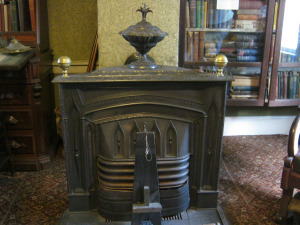 lights? The town probably did, a modest house like Rose’s probably not. Telephones? Again, rich people might, other homes probably not. Coal stove or fireplace? Coal stove. Most of the wood in this part of Massachusetts had been cut down for building. Quill pen or fountain pen? Fountain pens were new. Infant formula – it existed but wasn’t a good nutritional replacement for breast milk. What time did bars close? Any time the owner wanted to. School on Saturdays? Likely a half day. How much did shoes cost? Three to four dollars.
lights? The town probably did, a modest house like Rose’s probably not. Telephones? Again, rich people might, other homes probably not. Coal stove or fireplace? Coal stove. Most of the wood in this part of Massachusetts had been cut down for building. Quill pen or fountain pen? Fountain pens were new. Infant formula – it existed but wasn’t a good nutritional replacement for breast milk. What time did bars close? Any time the owner wanted to. School on Saturdays? Likely a half day. How much did shoes cost? Three to four dollars.
Medical/midwifery details: Did doctors know about germ theory? Apparently. How did midwives listen to the fetal heartbeat? With a Pinard horn. Was the nearby hospital built?  yes, six years earlier.
yes, six years earlier.
I taught prepared childbirth classes and worked as a doula many years ago, so I have knowledge of the normal process of pregnancy and birth, which hasn’t changed in, well, since prehistory, one imagines.
Police procedure: Did they have an alarm system? Yes. Did they use some kind of police barrier (in lieu of yellow plastic tape)? Probably not. Would they have typed up a handwritten police report? Unlikely. Did they use fingerprints or blood type as evidence? It was fascinating to read that Mark Twain proposed the use of fingerprints in a novel some years before the procedure was shown to be scientifically valid (and of course this went into the book!). No to blood typing.
Transportation: In Amesbury, there was a horse-drawn trolley through town that also crossed the bridge to the shipping town of Newburyport (and yes, the Esses-Merrimack Bridge was built by then). The electric trolley didn’t come in for 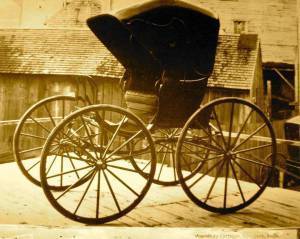 four more years. Rose also acquires one of the new “safety bicycles” with both wheels of even size.
four more years. Rose also acquires one of the new “safety bicycles” with both wheels of even size.
But carriage terminology! Buggies, gigs, shays, phaetons, carriages; two wheels and four wheels; one person or more than one; covered or not; and so much more. Luckily I can walk right up to a couple of real carriages from the 1880s in my town and get a feel for how beautiful they were.
Quaker stuff: I’m a long-time Friend, and I attend the same Meeting John Greenleaf Whittier did, so I already knew quite a bit about the practice and beliefs of Quakers. 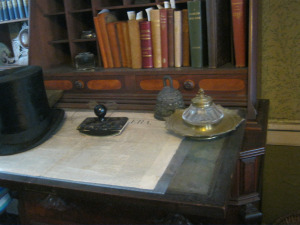 Whittier is a secondary character in the book, though, sort of a mentor to Rose, so I had a lovely time touring his home three blocks away and finding out the details of his study and his life, and I’ve been reading his biography. I learned how he’d escape out the back door if he didn’t feel like seeing one of his many admirers and I saw his silver-tipped cane.
Whittier is a secondary character in the book, though, sort of a mentor to Rose, so I had a lovely time touring his home three blocks away and finding out the details of his study and his life, and I’ve been reading his biography. I learned how he’d escape out the back door if he didn’t feel like seeing one of his many admirers and I saw his silver-tipped cane.
All the Quakers in the story speak using “thee” and “thy” and use Friends’ terminology for the days of the week and months of the year: Sunday is First Day, Monday is Second Day; January is First Month, and so on. Did Quaker women only wear gray? No, they also wore muted shades of green, red, blue, but with simple styling to their dress.
I’m sure I’ve gotten a few things wrong, or missed details I could have included. My expert readers will help me out in that department, and I’ll keep checking things on my own until the book finally goes out.
I’ve had such a good time poking around in microfilm of newspapers of the time, local histories, the internet, and in person. This series isn’t even under contract (yet), but I’m determined it will be. I want to keep writing historical mysteries until I’m history, myself.
[Late addition:] I have also been reading other mysteries written in the same era to see 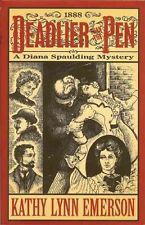 how other authors handle the historical details. Kathy Lynn Emerson‘s Diana Spaulding series (from which Kathy was generous enough to share her research bibliography with me!), Anna Loan-Wilsey‘s Hattie Darvish mysteries, Christine Trent’s Lady of Ashes mysteries, Ann Parker’s Silver Rush mysteries, Victoria Thompson’s Gaslight mysteries (which feature a midwife-sleuth), and more. All very helpful!
how other authors handle the historical details. Kathy Lynn Emerson‘s Diana Spaulding series (from which Kathy was generous enough to share her research bibliography with me!), Anna Loan-Wilsey‘s Hattie Darvish mysteries, Christine Trent’s Lady of Ashes mysteries, Ann Parker’s Silver Rush mysteries, Victoria Thompson’s Gaslight mysteries (which feature a midwife-sleuth), and more. All very helpful!
Readers: Do you read historicals? Have a favorite era? What kind of wrong detail would make you put a book down? What would you give a pass to?
Filed under: Edith's posts Tagged: amesbury, historical mystery, John Greenleaf Whittier, midwife

June 25, 2014
Wicked Wednesday: Lessons from Cozies
On Wicked Wednesdays, we all chime in on a topic. This week, what cozy series have you learned from? What has made that enjoyable?
Julie: Two series come to mind. First of all, Elizabeth Peters Amelia Peabody series. It is about Egyptologists at the turn of the last series. Really fun, funny, and I felt like I was learning about the scientific methods of the time. And then, when I went to Egypt, I brought Barbara Mertz‘s book Temples, Tombs, and Hieroglyphics. Interesting, since Barbara Mertz and Elizabeth Peters were one and the same person.
The other series is Kate Carlisle’s Bibliophile series. I love learning about book binding, and the frame she has put around the series.
Jessie: I know I’ve mentioned her before but I love all the series by Charlotte MacLeod. Her books are lessons in silly fun that is balanced by well developed, meaningful relationships between people. Her characters are funny but they way she treats them celebrates who they are and the lives they live in a way that shows the regard she has for them.
 Edith: Many years ago, when I realized I wanted to write a mystery novel, I was reading Katherine Hall Page‘s series, featuring caterer Faith Fairchild in a fictional Massachusetts town; Susan Wittig Albert‘s China Bayles herb shop series, set in Texas; and Diane Mott Davidson‘s Goldy Bear Catering Mystery Series. I drew lessons about writing a foodie cozy from all of these and kept them in the back of my mind, I guess. They all feature a
Edith: Many years ago, when I realized I wanted to write a mystery novel, I was reading Katherine Hall Page‘s series, featuring caterer Faith Fairchild in a fictional Massachusetts town; Susan Wittig Albert‘s China Bayles herb shop series, set in Texas; and Diane Mott Davidson‘s Goldy Bear Catering Mystery Series. I drew lessons about writing a foodie cozy from all of these and kept them in the back of my mind, I guess. They all feature a 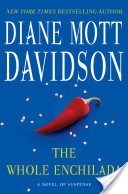 female protagonist with a quirky female buddy. The amateur sleuth is courageous, funny, and an entrepreneur, and either at the start or later in the series they all have children at home, which I did at the time (and still do, blessedly, just not at home!). Who knows, my protagonists Cam or Lauren might acquire a child or two one of the these days!
female protagonist with a quirky female buddy. The amateur sleuth is courageous, funny, and an entrepreneur, and either at the start or later in the series they all have children at home, which I did at the time (and still do, blessedly, just not at home!). Who knows, my protagonists Cam or Lauren might acquire a child or two one of the these days!
Sherry: I came across Clare O’Donohue’s Someday Quilts Mystery Series because she was one of the authors on a panel I moderated at Malice. In the Double Wedding Ring, the characters, plot, and setting all were fully developed and felt real. I have several old quilts that my grandmother made. One of them is a double wedding ring. It was interesting to read about modern day quilt and pattern making while reading a great mystery.
 Barb: I always mention Cleo Coyle’s Coffee House Mysteries. I love the way she turns Greenwich Village and the community around the Village Blend Coffee House into perfect cozy setting. Her characters are diverse and interesting and the back story (and how it plays out in the present) is fabulous.
Barb: I always mention Cleo Coyle’s Coffee House Mysteries. I love the way she turns Greenwich Village and the community around the Village Blend Coffee House into perfect cozy setting. Her characters are diverse and interesting and the back story (and how it plays out in the present) is fabulous.
I also learned a lot from three Maine-based series: Kaitlyn Dunnett’s Liss MacCrimmon Scottish Mysteries, Sarah Grave’s Home Repair is Homicide Series and Leslie Meier’s Lucy Stone Mysteries. At first I was a little intimidated to jump into their ranks, but now that I have I realize what an inspiration these books are.
Readers, your turn: What cozy series have you learned from? What has made that enjoyable?
Filed under: Wicked Wednesday Tagged: Charlotte MacLeod, China Bayles, Clare O'Donohue, Diane Mott Davidson, Faith Fairchild, Goldy Bear, katherine hall page, Susan Wittig Albert, The Double Wedding Ring

June 24, 2014
Welcome Author Anna Loan-Wilsey
by Barb, in Maine, wishing it would warm up just a tick.
 Say Happy Book Birthday to Anna Loan-Wilsey. A Sense of Entitlement, her third book featuring traveling secretary and dilettante detective Hattie Davish, releases today.
Say Happy Book Birthday to Anna Loan-Wilsey. A Sense of Entitlement, her third book featuring traveling secretary and dilettante detective Hattie Davish, releases today.
I first met Anna when we stood next to each other signing books at the Kensington table at Bouchercon in Albany. We discovered in addition to sharing a publisher, we also shared an agent (John Talbot).
Anna’s historical mysteries are set in the 1890s. A Sense of Entitlement brings Hattie to Newport, Rhode Island–i.e. right into Wicked Cozy territory. So we thought release day was a good time to chat.
Hi Anna. Welcome to Wicked Cozys. Your protagonist Hattie Davish is a traveling secretary. Why did you decide that was the occupation for your amateur sleuth, and what attracted you to Hattie?
 I originally thought my amateur sleuth would be a librarian since I was a librarian and was told to “write what you know.” But when I decided I wanted to set each book in a different setting (hoping to satisfy both a need to keep the series fresh and satisfy my love of travel), I needed a viable profession for a woman from the 1890’s that could also move about. When I was researching the era, I discovered that lady “typewriters” in typing or steno pools were becoming common, working mostly for big industry. Making the leap from “typewriter” to private secretary allowed Hattie to travel to or with her wealthy employers and enabled me to throw her into a variety situations that would require more of her than her secretarial skills.
I originally thought my amateur sleuth would be a librarian since I was a librarian and was told to “write what you know.” But when I decided I wanted to set each book in a different setting (hoping to satisfy both a need to keep the series fresh and satisfy my love of travel), I needed a viable profession for a woman from the 1890’s that could also move about. When I was researching the era, I discovered that lady “typewriters” in typing or steno pools were becoming common, working mostly for big industry. Making the leap from “typewriter” to private secretary allowed Hattie to travel to or with her wealthy employers and enabled me to throw her into a variety situations that would require more of her than her secretarial skills.
Hattie attracted me because she would have to be exceptional at her job to succeed in an occupation typically performed by men while at the same time having to live within the constraints put on women during the late nineteenth century.
Your latest novel, A Sense of Entitlement, brings Hattie to Newport, Rhode Island. Were you able to visit Newport for your research? What did you discover there that you might not have found if you hadn’t gone?
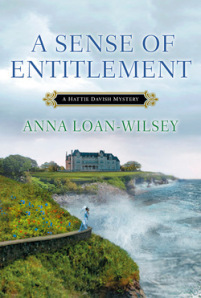 I definitely visited Newport, RI to research my book. I make sure to visit every location where my novels are set as I never know what part of the local history will find its way into my book. And this was no more true than for Newport! Besides discovering the obvious things like the scent of the air, the practical distances between key locations in town and what walking the Cliff Walk would truly be like, I discovered while reading the archived newspapers at the Newport public library, that a telegraph operator’s strike occurred the very week Hattie would be arriving in the summer of 1893. This little tidbit, which took up less than an inch on the page, ended up inspiring the main plot idea of book– pitting Newport’s elite summer residents against the labor movement that was starting to gain momentum throughout the country.
I definitely visited Newport, RI to research my book. I make sure to visit every location where my novels are set as I never know what part of the local history will find its way into my book. And this was no more true than for Newport! Besides discovering the obvious things like the scent of the air, the practical distances between key locations in town and what walking the Cliff Walk would truly be like, I discovered while reading the archived newspapers at the Newport public library, that a telegraph operator’s strike occurred the very week Hattie would be arriving in the summer of 1893. This little tidbit, which took up less than an inch on the page, ended up inspiring the main plot idea of book– pitting Newport’s elite summer residents against the labor movement that was starting to gain momentum throughout the country.
This month on Wicked Cozy Authors we’re focused on research. I’m fascinated by the research historical mystery writers do. How and when do you do your research? How does it weave into the process of writing the novel?
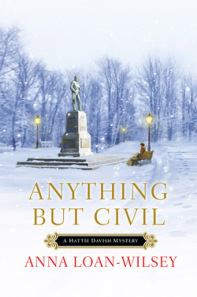 As I mentioned, a major component of my research is my visit to the book’s location. I usually spend 3-4 days there walking the streets, photographing the architecture, and combing the library’s archives, local book collection, period newspapers and appropriate yearly city directories. I literately spend every waking moment trying to soak up the atmosphere, the attitude and the history of a location for as long as I can. (And for Newport, this was a joy to do. It felt more like vacation than work!) One way I’m able to do as much as I do in a short time is by using my digital camera to capture everything from newspapers on microfilm from the exact dates Hattie will be in Newport, pictures of “cottage” gardens in a turn of the century book available only at Salve Regina University library to all the names of the real millenary shops listed in the 1893 city directory or the exact 1893 city atlas. Not only does it save me time but I also capture historic details that I can use later.
As I mentioned, a major component of my research is my visit to the book’s location. I usually spend 3-4 days there walking the streets, photographing the architecture, and combing the library’s archives, local book collection, period newspapers and appropriate yearly city directories. I literately spend every waking moment trying to soak up the atmosphere, the attitude and the history of a location for as long as I can. (And for Newport, this was a joy to do. It felt more like vacation than work!) One way I’m able to do as much as I do in a short time is by using my digital camera to capture everything from newspapers on microfilm from the exact dates Hattie will be in Newport, pictures of “cottage” gardens in a turn of the century book available only at Salve Regina University library to all the names of the real millenary shops listed in the 1893 city directory or the exact 1893 city atlas. Not only does it save me time but I also capture historic details that I can use later.
 After I return home and start writing is when I discover what actual historic details I need. For my first draft, when I want to include a particular detail, I leave a blank space or a note and return later, as finding or verifying a detail can take anywhere from a few minutes to a couple of hours. To find those details, I’ll consult what I learned on my site visit or if I find I didn’t gather the necessary data, I use books I ordered through Interlibrary Loan from my public library, the internet or my own library of reference books, which includes a encyclopedia of carriages, a history of dining and food in Victorian America, a dictionary of American furniture, a half-dozen “the meanings of flowers” dictionaries and several Sears & Roebuck mail-order catalogs from the 1890′s.
After I return home and start writing is when I discover what actual historic details I need. For my first draft, when I want to include a particular detail, I leave a blank space or a note and return later, as finding or verifying a detail can take anywhere from a few minutes to a couple of hours. To find those details, I’ll consult what I learned on my site visit or if I find I didn’t gather the necessary data, I use books I ordered through Interlibrary Loan from my public library, the internet or my own library of reference books, which includes a encyclopedia of carriages, a history of dining and food in Victorian America, a dictionary of American furniture, a half-dozen “the meanings of flowers” dictionaries and several Sears & Roebuck mail-order catalogs from the 1890′s.
 One excellent internet resource is the NY Times Archives Online. Besides my 1900 dictionary, I use the newspaper archive extensively to verify whether certain words and phrases are historically appropriate. I was lucky in that Newport has a long, well-recorded history. I found lots of wonderful books that I consulted that were very specific about the town and the wealthy that summered there, including a book written around 1915 called, Confessions of a Social Secretary, by a woman who worked for a well-known Newport Socialite. The details that provided were invaluable.
One excellent internet resource is the NY Times Archives Online. Besides my 1900 dictionary, I use the newspaper archive extensively to verify whether certain words and phrases are historically appropriate. I was lucky in that Newport has a long, well-recorded history. I found lots of wonderful books that I consulted that were very specific about the town and the wealthy that summered there, including a book written around 1915 called, Confessions of a Social Secretary, by a woman who worked for a well-known Newport Socialite. The details that provided were invaluable.
 What are you working on now?
What are you working on now?
I’m currently working on Hattie’s next adventure, A DECEPTIVE HOMECOMING. Unlike the previous books in the series, Hattie is not preoccupied with work but returns to her hometown of St. Joseph, Missouri, home of the Pony Express, and site of Jesse James’ demise, for a funeral. Unfortunately for Hattie, the body in the casket is not the person she expected to see.
Thanks for coming by and telling us about your fascinating books, Anna. Readers, do you have questions or comments for Anna?
About Anna Loan-Wilsey
Anna lives in a Victorian farmhouse in the Iowa countryside with her patient husband, inquisitive four-year-old daughter and her old yellow dog. She was born and raised in Syracuse, NY but has lived in Finland, Canada and Texas. She has a BA in Biology from Wells College in Aurora, NY and a MLIS from McGill University in Montreal. She’s a biologist, librarian, information specialist and now with the Hattie Davish Mysteries Series, a novelist.
Filed under: Guest posts Tagged: A Lack of Temperance, A Sense of Entitlement, anna loan-wilsey, Anything But Civil, Hattie Davish, John Talbot, Kensington Publishing, newport rhode island

June 23, 2014
“People Say My Main Character is Unlikeable”
by Barb Ross, freezing her &*$# off in Maine
Recently, Ramona DeFelice Long wrote a blog post called How to Write a Protagonist of Interest. It’s a great post and I recommend it. And it got me thinking about the following:
If I had a nickel for every time I’ve been in a writing class or seminar and someone has wailed, “(Friends, my writers group, prospective agents, prospective publishers) say my protagonist is unlikeable. What to I do?” let’s just say I’d have a whole pile of nickels. Usually this lament comes from someone early in their writing career. Sometimes it’s because the author has committed to a protagonist who is relentlessly awful, but often, the writer likes the protagonist just fine, and doesn’t understand why others react negatively.
Sometimes the answer to this question degenerates into a discussion of whether protagonists have to be “likeable,” so lets get that out of the way. I don’t think protagonists have to be nice, good, moral or event decent. But they do have to be compelling and more than anything else we have to care what happens to them. Otherwise, why keep reading to find out? Let’s put it this way, when readers pick up your book, they’re committing to spend six to twenty hours in your world and with your protagonist. Would you volunteer to fly cross country sitting next to someone you found unredeemably irritating, self-centered, shallow, or deliberately stupid? How about a flight to Australia? Didn’t think so. Time is the most precious resource humans have. Don’t unknowingly make it difficult for them to give it to you.
So why might a writer be getting the feedback that their protagonist is unlikeable? I’ve been around the block a few times, and here are my observations.
1) The protagonist doesn’t react to what’s going on around them like a human being.
In my experience, there are several reasons for this.
a) In early drafts, writers can be so busy getting from point A to point B in the plot, events just wash over the protagonist. He never pauses long enough to feel his feelings, much less to tell the reader about them. As a result, the protagonist comes across as cold and robotic, even if that’s not what the author intended.
b) The writer knows too much. The writer knows the protagonist’s mom is going to survive that automobile crash just fine, so the writer glosses over what the protagonist, who doesn’t know that at all, is feeling in the moment.
c) Do I have to say it? The protagonist takes a date to a special meal at a fancy restaurant. The food is terrible, the service is slow and the portions are small. The writer thinks since they “showed” us this, they don’t have to “tell” us how the protagonist reacts to this situation. Anyone would be disappointed, angry, etc. But your protagonist is not “anyone.” He or she is a specific person with a specific background and how he reacts in this situation is going to tell your reader a lot about him. What if he doesn’t get angry at all? That’s interesting. You can “show” his reaction in dialogue, or “tell” us in his head, but you can’t fail to write it down.
Fortunately, the fix for these three situations is “easy.” Go back, read your manuscript and think about what your protagonist is feeling in the moment. Like the reader, your protagonist doesn’t know what’s going to happen next. He only knows what’s happened up to now. Make sure he is reacting to what’s happened up to now like the very specific human being he is.
2) The writer uses their manuscript to air every grievance they’ve ever had.
You’re in the grocery store. The person ahead of you in the ten items or fewer line has 15 items. Now they’re paying by personal check! It shouldn’t be allowed! You’re going to make this point (and many others like it) in your book.
First of all, you are not the first person to have observed this situation, so unless your protagonist is buying diapers and formula having left her baby in the car with her boyfriend while they’re fleeing from the mob, I would maybe skip this observation. But if you must include it, make sure it’s balanced by your protagonist walking out of the grocery into a beautiful day–and enjoying it. Otherwise, she’ll come off like the old man endlessly yelling at the disrespectful kids to get off his lawn. Not someone you want to spend time with.
3) Your protagonist has compelling traits, but you’ve never shown them.
Your protagonist is outwardly prickly, difficult, down and out, but under it all, he adheres to a strict moral code, or she loves her mother, or he is loyal to his friends. You need to show us this early, in a dramatic way, when we can still get attached. Donald Maass says in the first five pages. We need to know, because we need to care.
4) If no one loves your protagonist, why should I?
Author Daniel Palmer got consistent feedback that Charlie Giles, protagonist of Delirious, his first suspense novel, was too rough around the edges to be likeable. A friend suggested he give Giles a dog. Daniel claims it’s the only change he made (though Monte is a very compelling dog). But it is pretty genius, no? If all of the above fail, give your protagonist something to love, and something that loves him, unconditionally. Maybe the rest of us will follow suit.
Readers, what do you think? What makes a protagonist likeable/unlikeable? What makes us care what happens to a character?
Filed under: Barb's posts Tagged: unlikeable protagonist

June 20, 2014
The Wicked Ask
The Wickeds are going to start two new blog series, and we’d love to hear what you think.
Did you know that our own Sherry Harris is an editor? Other readers of this blog are as well. Editing is a different skill set than writing, so we are going to start asking editors for their thoughts on plotting, structure, character development. . .and what else? What would you like to ask an editor?
We’ve had a few conversations about research on the blog. So we’ve decided to start a series called “We Ask the Expert”. One of the great things about doing research is that you meet very interesting people who have expertise in specific areas. We want you to meet some of them.
Also, what would you like to hear more about? Anything you’ve always wanted to kno w, but weren’t sure how to ask? Can the Wickeds help?
w, but weren’t sure how to ask? Can the Wickeds help?
So, dear readers, any questions for our editors? Thoughts on experts? Share all in the comments.
Filed under: Ask the Expert, Editors, Experts, Group posts, Guest posts


